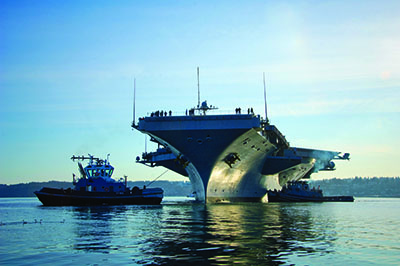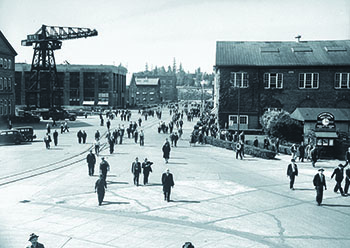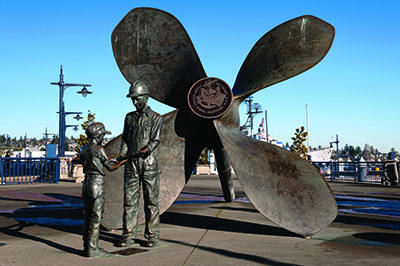
ESTABLISHED IN 1891, Navy Yard Puget Sound was the only West Coast facility equipped to dry-dock battleships and aircraft carriers when Japanese planes bombed Pearl Harbor 50 years later. In wake of the attack, five of Battleship Row’s six survivors limped in for repairs, towing a new era for Bremerton, Washington—a quiet navy town located an hour west of Seattle by ferry.
In a way, these ghosts of Pearl Harbor still haunt Bremerton. As I perch on a waterfront bench near what is now called the Puget Sound Naval Shipyard and Intermediate Maintenance Facility, the footfalls of boots on concrete, metallic groan of the shipyard gate, and distant pounding of hammers still seem to echo from the time when a small, greasy town burst into a lively city that proudly repaired or modernized more than 350 vessels for the wartime Pacific Fleet. The tree-lined walkways, tightly packed rows of glass storefronts, and flashy theater marquees remain largely as they were during the war. But on this cloudless late-July weekday, Bremerton is lacking the one thing it had in surplus in the early 1940s: people.
Bremerton’s shipyard, nestled by the deep-water inlets of Puget Sound, has always been the city’s economic anchor. Weary of sending Pacific ships to Canada for repairs, the navy sought a location for its own maintenance facility and purchased 190 acres of Bremerton’s shoreline the same year the town was platted. By 1940, the shipyard boasted more than 6,000 employees and the unemployment rate in this soundside burg of 15,000 was about 10 percent lower than the national average.
The attack on Pearl Harbor destroyed two of the nine battleships in the Pacific Fleet and left six in need of repair. The USS Tennessee was the first to arrive at Navy Yard Puget Sound on December 29, 1941, with simple instructions: mend the badly damaged aft section and return it to service as quickly as possible. It steamed away an impressive 53 days later thanks to the engineers, shipwrights, machinists, painters, and others from around the country who were joining the shipyard’s payroll at a rate of 60-70 people a day.
A tall wrought iron fence separated the shipyard from the city, but the effects of the shipyard’s staggering growth rippled beyond it. As Bremerton’s population climbed rapidly toward an estimated peak of more than 80,000, building permit sales skyrocketed and new federal housing projects offered rent as low as $17 per month. The Black Ball ferry line made 29 trips a day carrying commuters to and from Seattle. Big businesses like J. C. Penney and Sears, Roebuck & Co. moved in almost overnight. Bremerton High School introduced factory-style shifts to accommodate a student population that more than doubled. In their off-hours, most teens had jobs either at the shipyard or the many entertainment venues that popped up all over town.
In Victory Gardens & Barrage Balloons: A Collective Memoir, local author Frank Wetzel describes wartime Bremerton through the eyes of high schoolers. “In truth, for teenagers it was a time of newly found independence and exuberance,” he writes. “We had jobs and money and freedom from parents who were preoccupied with the war—a war that united America as seldom before, and never since.”

One of those teenagers was Nada Willmschen, a dear friend of my family who, at age 14, alternated her evenings between her job taking tickets at movie houses and accompanying sailors to dance halls and skating rinks. “I wasn’t very old,” she told me. “But neither were they.” When the shipyard’s double-bell steam whistle signaled the end of the day shift at 4:45 p.m., downtown Bremerton flooded with yard workers exhausted from regunning battlewagons and scraping barnacles from sea-soaked hulls, and servicemen fresh from the Pacific, brimming with shore leave revelry. “I think they did more battling on our streets than they did in the big fight,” Nada recalls.
The only sign of scuffle now is a poster on Fourth Street calling on the community to rescue the long-shuttered Roxy Theater from potential development. Peering through the glass doors of the old theater—which opened in May 1941 with the premiere of the comedy The Devil and Miss Jones—I imagine Nada dolled up and smiling as she admits throngs of patrons lined up in the afternoon trying to make the cut for an evening show. It is still hard to believe that Fourth Street was once the heart of Bremerton, beating with the swinging radio rhythms of Glenn Miller and His Orchestra. Today it is empty, save the occasional office worker on a midmorning coffee run and vocal seagulls scanning for dropped bagels.
Wartime Bremerton wasn’t all roller skates and movie dates. Antiaircraft guns, bunkers, and barrage balloons were installed all over town for defense against a possible Japanese attack on the vital shipyard. Nada recalls ferry trips across Puget Sound with her girlfriends to visit convalescing sailors in Seattle hospitals whom they had met on previous port calls. “It was something that you did because you knew you had to help them either get back home to their families, or get back out to sea,” she says. Bremerton sent hundreds of its young men to war, and nearly 300 with ties to surrounding Kitsap County did not return.
The still-active shipyard is off-limits to visitors, but I spot the occasional matte gray hull of one of the dry docks’ ships visible between rows of tall numbered buildings across the fence still circling the yard. The best peek inside is offered by the Puget Sound Navy Museum, housed within the original administrative office building located a stone’s throw outside the yard’s east gate. Exhibits tell of how the war birthed incredible innovation and patriotism, from shipwrights who freed up steel by pioneering the use of resin and wood laminates, to overall-clad women who made up 15 percent of the yard’s workforce at the height of wartime operations.

When Japan surrendered, 32,000 people were employed at the shipyard. Operating five dry docks 24 hours a day, they had repaired 26 battleships, 18 carriers, 13 cruisers, 79 destroyers, and built 53 new vessels. After the war, the shipyard converted ships to troop transports that brought servicemen home, and then transitioned to retiring and upgrading war vessels. By the end of 1946, Bremerton saw its population shrink to a fraction of its former might.
But the navy’s wartime elbow grease left permanent marks. From colorful murals to the ship-shaped pools and fountains that gurgle throughout Puget Sound Naval Shipyard Memorial Plaza, Bremerton’s pride in its over 125 years of backstage service to the navy is visible all over town. Today, at what remains the largest naval shore facility in the Pacific Northwest, 12,000 workers maintain and recycle nuclear-powered surface ships and subs, while Bremerton’s 38,000 residents enjoy relative prosperity.
At the end of the day, I board the Seattle-bound M/V Walla Walla with dozens of off-duty yard workers who exchange their white hard hats for rumpled-coat pillows and nap on the ferry’s benches during our hour-long passage. As we round Puget Sound’s Sinclair Inlet, the shipyard’s iconic hammerhead crane fades from view beneath the jagged backdrop of the Olympic Mountains and the frigid water slaps the hull with syncopation reminiscent of a classic Glenn Miller tune.✯
Bremerton sits at the heart of Kitsap Peninsula in western Washington. From Seattle-Tacoma International Airport, drive to Seattle and ferry to Bremerton, or make the one-hour drive around the south side of Puget Sound via the historic Tacoma Narrows Bridge.
WHERE TO STAY AND EAT
Bremerton has the usual lineup of chain hotels with military discounts. When it’s time to eat, follow the stream of blue-camouflage fatigues to a local hole in the wall, like Sweet and Smokey Diner on Park Avenue, where you can grab some tasty barbecue (sweetandsmokeydiner.com)—or try some delicious Mexican cuisine at El Balcón on Pacific Avenue (facebook.com/Bremelbalcon) and carry out an order to the waterfront, where there is ample outdoor seating.
WHAT ELSE TO SEE AND DO
The Puget Sound Navy Museum (pugetsoundnavymuseum.org) and Kitsap History Museum (kitsapchs.org) paint complementary portraits of wartime Bremerton in and outside the shipyard gates. Tour the USS Turner Joy (ussturnerjoy.org), the destroyer of 1964 Gulf of Tonkin fame docked on Bremerton’s waterfront. Catch a concert or comedy show at the Admiral Theatre (admiraltheatre.org). Take a ferry for a day trip to downtown Seattle or drive to Olympic National Park (nps.gov/olym) on the adjacent peninsula and explore the diversity of Washington’s ecosystems.
This story was originally published in the May/June 2017 issue of World War II magazine. Subscribe here.





